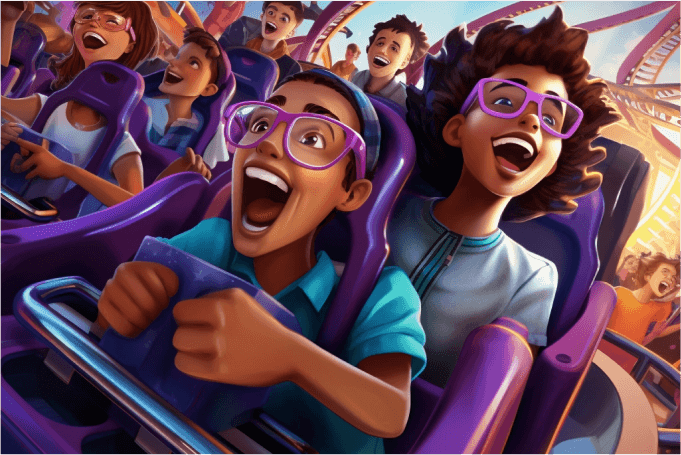Help
Acceleration1
The rate of change in velocity (the speed of an object in a certain direction) is known as acceleration. Whether an object is speeding up, slowing down, or changing direction, it is accelerating. Most amusement park rides involve acceleration. On a downhill slope or a sharp curve, a ride will probably increase in velocity or accelerate. While moving uphill or in a straight line, it may decrease in velocity or decelerate. The force of gravity pulling a roller coaster down hill causes the roller coaster to go faster and faster, it is accelerating. The force of gravity causes a roller coaster to go slower and slower when it climbs a hill, the roller coaster is decelerating or going slower. The acceleration of a roller coaster depends on its mass and how strong is the force that is pushing or pulling it.
Centripetal Force2
When the coaster is moving through the loop centripetal force comes into play. This is the force that causes an object to move in a circle. It literally means the “center-seeking” force. For example, when you go down a curved slide on a playgroud, Gravity makes you go down the slide in a straight line but because the slide curves, centripetal force makes you slide along the curve. You think you are being thrown to the outer edge of the slide but gravity is just trying to make you go straight on a curved slide. The coaster will behave in the same way.
To travel in a circle, a force pointing to the inside of the circle, or curve, is needed. The force pointing to the inside is called the centripetal force.
Energy3
Energy is the ability of a body (for example, the roller coaster) to do work.
- Kinetic energy – energy that is being used, the energy caused by motion.
- Potential energy – energy that is stored for later use.
- Law of Conservation of Energy – Energy can change from one form to another but cannot be created or destroyed.
When you ride a roller coaster a motor does the work to get you up the first hill. As the coaster is being pulled up the hill by the motor it is storing more and more potential energy. That potential energy is turned into kinetic energy as gravity pulls you down the first hill. The farther you go down the hill, the more potential energy is changed into kinetic energy, which you feel as speed. The ride goes fastest at the bottom of the hill because more and more of the potential energy has been changed to kinetic energy.
As you go up the next hill, kinetic energy is changed into potential energy and the ride slows down. The higher you go, the more energy is changed and you feel the car slow down. This conversion of kinetic energy to potential energy and vice versa continues as you go up and down hills for the rest of the ride. The total energy does not increase or decrease; it just changes from one form to the other. Notice that the first or lift hill is the highest point in the coaster. Why is that?
However, some of the energy is changed into friction. Wind resistance, the rolling of the wheels, and other factors all use some of the energy. Coaster designers know that friction plays a part in the ride. Therefore, they make each successive hill lower so that the coaster will be able to make it over each peak.
A roller coaster works because of two things: gravity and the law of conservation of energy. A roller coaster is similar to a slide except it is longer and you ride in a train car rather than on the seat of your pants. The wheels reduce friction: it’s easier to let something roll than to let it slide.
Force4
Force is a push or pull. Balanced forces are equal forces that are applied in opposite directions and result in no change in velocity. Unbalanced forces are forces that are not equal and opposite, and they result in a change in velocity.
Friction5
Friction is a force that works in the opposite direction of an object that is moving along a surface. Friction can come in many forms, but it always resists motion. The amount of friction depends mainly on the materials involved.
Accompanying all motion is friction6, the resistance produced when two surfaces rub together. No surface is perfectly smooth. The tiny ridges in a “smooth surface or the larger bumps and hollows in a rough one, catch and resist when the surfaces rub together. Surface pressure is another condition that affects friction. A heavy object has more friction than a lighter one.
However some of the energy is changed into friction. Coaster designers know that friction plays a part in the ride. Therefore, they make each successive hill lower so that the coaster will be able to make it over each peak.7 Coaster designers also take advantage of friction to slow the coaster and bring it to a safe stop when breaks are applied at the end of the ride.
Friction is a force that works in the opposite direction of an object that is moving along a surface. Friction can come in many forms, but it always resists motion. The amount of friction depends mainly on the materials involved.
Gravity6
The most interesting and significant force that acts on a roller coaster is the force of gravity. Gravity is the force that pulls all objects in the universe toward one another. The effective acceleration or deceleration due to gravity depends on the inclined angle of the track relative to ground; the steeper the slope is the greater the effective acceleration.
G’s7
A unit that is commonly used to describe forces we feel is the g. One g is equal to the force of earth’s gravity. When the space shuttle takes off, the astronauts feel about 3 g’s of force (three times the force of earth’s gravity).9
Hill #18
Think about the following questions when setting the height for Hill #1.
- Is the hill height high enough to provide enough potential energy for the Coaster to make its way over the Hill #2 and through the loop?
- If the speed of the coaster is too high when it goes over the crest of a hill, what happens? Why?
- How does a change in gravity setting affect the motion of the coaster as it goes up and down hills and around the loop?
- Can you really change gravity on the Earth?
Hill #29
Think about the following questions when setting the height for Hill #2.
- Why does the height of the second hill affect the ability of the coaster to go safely around the loop?
- What settings for the heights of the first and second hill cause the coaster to either not get around the loop or crash through the loop?
- Is the friction set so that the Coaster may go fast enough to make its way down Hill #2 and through the loop?
- How does gravity affect the coaster’s ability to stay on the track?
Inertia10
If a body, for example a roller coaster, is standing still, it won’t want to move unless some force pushes or pulls it. This resistance of the roller coaster to move is called inertia. The more mass a body has the more inertia it has.
If the roller coaster is moving, it will want to keep moving, along the direction of motion, unless something causes it to speed up or slow down. This resistance of the moving roller coaster to changing its velocity is another example of its inertia. Again, the greater the mass of the body, the more inertia it has.
Look design and physics11
You must also decide on the size of the Loop. Much of the excitement around roller coaster rides centers on the ones that loop or go through a corkscrew. You experience not only the thrills of tremendous speed and falling from great heights, but also the exhilaration of being turned upside down in the process.
If you look at the shape of the curve in a looping roller coaster, you will see that it is not a circle but a teardrop shape. That shape is called a clothoid loop. It was first described by mathematical genius Leonard Eurler of Switzerland in the 18th century. Only G’sly did roller coaster engineers realize that it was the perfect shape for achieving the long sought after goal of the roller coaster somersault.
Mass12
Mass is the amount of matter in an object.
Momentum13
An object’s momentum is its mass multiplied by its velocity. If its mass or velocity is large, an object will have a large momentum. The more momentum an object has, the harder it is to stop the object or change the object’s direction.
Sir Isaac Newton14
Newton was one of the most influential scientists of the seventeenth century. He discovered three basic laws that explain all aspects of motion. To build a roller coaster it is very useful to know something about these famous laws.
Newton’s first law of motion states that objects at rest tend to stay at rest, and objects that are moving tend to continue moving. This tendency of objects to resist changes in motion is called inertia.
Newton’s second law of motion states that when an unbalanced force is applied to an object the object accelerates. The law goes on to say that the amount of acceleration depends on the mass of the object and the amount of force applied to it. A greater force applied to an object results in greater acceleration. Increases in mass result in less acceleration.
Newton’s third law of motion states that for every force there is an equal and opposite force. These forces are called action forces and reaction forces.
Simply stated Newton’s three laws of motion are15
- An object moving in a straight line will keep moving in that direction unless acted on by an outside force.
- If an object is moved by a force, it will move in the direction of the force. Also the greater the force, the faster the object moves.
- For every action there is an equal and opposite reaction.
Speed16
Speed is distance divided by time or the rate at which an object (the roller coaster) moves. Speed, velocity and acceleration are all-important concepts to understand when building a roller coaster.
Roller coasters must balance between thrills and safety. The ride should be as safe as possible. On the other hand, passengers ride a coaster for the death-defying thrill. The key to a successful coaster is to give the rider the thrill of speed and acceleration. It all comes down to speed control. To achieve this, the hills, curves, dips, straight aways, braking systems and loops are not randomly designed. They are carefully designed by engineers who have a deep understanding of the science of motion, properties of materials and structural design and a keen understanding of safety. The basic aspects of this science of motion are a central part of this demonstration.
Velocity17
Velocity is the speed of an object in a certain direction. When direction changes, velocity changes.
A ride at the amusement park may run at a constant speed, but its velocity is constantly changing when its direction of motion is changing.
A roller coaster is called a coaster because once it starts it coasts through the entire track. No outside forces are required for most coasters. (A few have double or triple lift hills and braking sections.) Roller coasters trade height for velocity and velocity for height. Most all calculations rely on using velocity measurements in one way or another.
The higher the velocity the quicker an object travels between two locations. Phrases like, how fast and how quickly, are used to describe velocity. Often the word speed is substituted for the word velocity. But the two are different.
Velocity is actually speed with direction. For example, 60 mph, west, is a velocity. “West” is the direction and 60 mph is the speed.18
Velocity differs from speed in that velocity tells not only the speed at which a roller coaster is moving but also its direction. If a roller coaster goes around a bend or a loop, even if its speed is not changing, its velocity is changing because its direction of motion is changing; this change requires the application of a force.
Weightlessness19
There are two ways to experience weightlessness. (1) Move far enough away from the planets and sun to where their pull is nearly zero. [Gravity acts over infinite distance. One can never completely escape it.] (2) Fall down at a rate equal to the pull of gravity. In other words, accelerate to the Earth speeding up 22 mph every second in the air. In order for a person to feel weight, a person must sense the reaction force of the ground pushing in the opposite direction of gravity.
In the absence of the reaction force a person will sink through the ground. Many amusement park rides generate the weightless sensation by accelerating down at close to 22 mph every second.
Weight20
Weight is the force with which an object is pulled toward the earth by gravity.
Weight is the pull of gravity. Typical weight units are pounds and newtons. (1 pound = 4.45 Newtons). On the moon, gravity pulls with 1/6 the force compared to the Earth. Therefore, a student on the moon weighs 1/6 of what she weighs on the Earth.
Work21
Work is the force used to move something in the direction of the force. If you hold a box, no work is being done on the box. If you drag the box, work is being done.
Work is how much you have to push or pull a roller coaster in order to move it for a certain distance. Work is done if a chain, pulled by a motor, pulls the roller coaster up to the top of a hill on the track. It takes work to lift a roller coaster to the top of the first hill in order to overcome the force of gravity.
The more mass the coaster has, the more work required to pull it to the top. The further a roller coaster must climb the more work that is required to get the coaster to the top of the hill. Work is done when the force of gravity pulls the coaster down a hill.
1 Science Anytime, Unit F Amusement Park, Hartcourt Brace & Company., 1995
2 Roller Coaster Science, Jim Wiese, John Wiley & Sons., 1994
3 Roller Coaster Science, Jim Wiese, John Wiley & Sons., 1994
4 Science Anytime, Unit F Amusement Park, Hartcourt Brace & Company., 1995
5 Roller Coaster Science, Jim Wiese, John Wiley & Sons., 1994
6 Science in Elementary Education, Peter C. Gega and Joseph M. Peters, Prentice Hall Inc., 1998
7 Roller Coaster Science, Jim Wiese, John Wiley & Sons., 1994
8 Science Anytime, Unit F Amusement Park, Hartcourt Brace & Company., 1995
9 Roller Coaster Science, Jim Wiese, John Wiley & Sons., 1994
10 Roller Coaster Science, Jim Wiese, John Wiley & Sons, 1994
11 Roller Coaster Science, Jim Wiese, John Wiley & Sons, 1994
12 Science Anytime, Unit F Amusement Park, Hartcourt Brace & Company., 1995
13 Science Anytime, Unit F Amusement Park, Hartcourt Brace & Company., 1995
14 Science Anytime, Unit F Amusement Park, Hartcourt Brace & Company., 1995
15 Roller Coaster Science, Jim Wiese, John Wiley & Sons., 1994
16 http://141.104.22.210/Anthology/Pav/Science/Physics/book/home.html
17 Roller Coaster Science, Jim Wiese, John Wiley & Sons., 1994
18 http://141.104.22.210/Anthology/Pav/Science/Physics/book/home.html
19 http://141.104.22.210/Anthology/Pav/Science/Physics/book/home.html
20 http://141.104.22.210/Anthology/Pav/Science/Physics/book/home.html
21 Science Anytime, Unit F Amusement Park, Hartcourt Brace & Company., 1995



